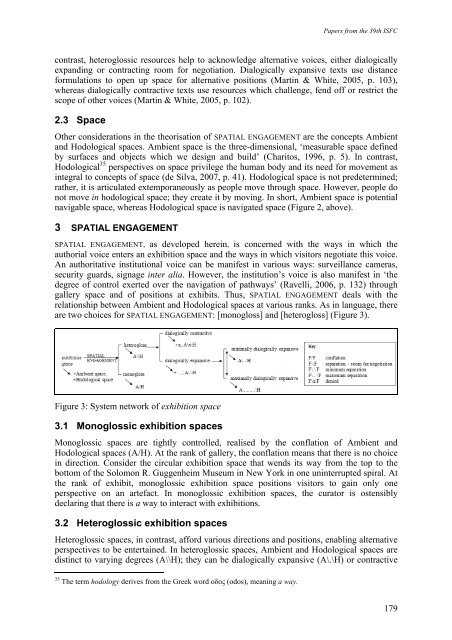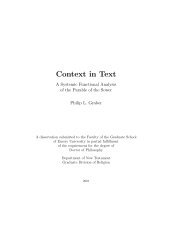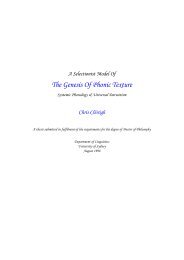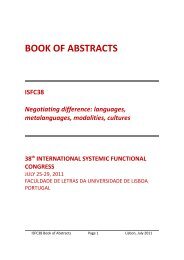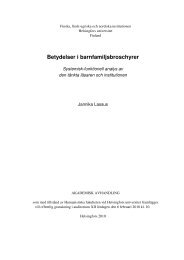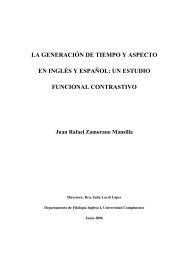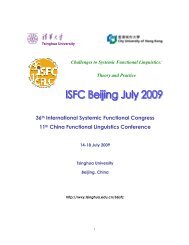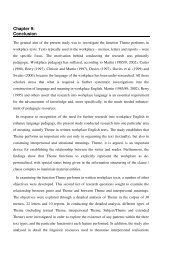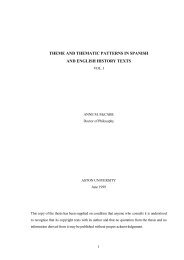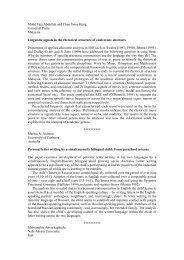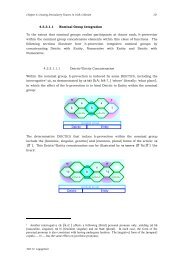the ISFC39 Proceedings - International Systemic-Functional ...
the ISFC39 Proceedings - International Systemic-Functional ...
the ISFC39 Proceedings - International Systemic-Functional ...
Create successful ePaper yourself
Turn your PDF publications into a flip-book with our unique Google optimized e-Paper software.
Papers from <strong>the</strong> 39th ISFCcontrast, heteroglossic resources help to acknowledge alternative voices, ei<strong>the</strong>r dialogicallyexpanding or contracting room for negotiation. Dialogically expansive texts use distanceformulations to open up space for alternative positions (Martin & White, 2005, p. 103),whereas dialogically contractive texts use resources which challenge, fend off or restrict <strong>the</strong>scope of o<strong>the</strong>r voices (Martin & White, 2005, p. 102).2.3 SpaceO<strong>the</strong>r considerations in <strong>the</strong> <strong>the</strong>orisation of SPATIAL ENGAGEMENT are <strong>the</strong> concepts Ambientand Hodological spaces. Ambient space is <strong>the</strong> three-dimensional, ‘measurable space definedby surfaces and objects which we design and build’ (Charitos, 1996, p. 5). In contrast,Hodological 35 perspectives on space privilege <strong>the</strong> human body and its need for movement asintegral to concepts of space (de Silva, 2007, p. 41). Hodological space is not predetermined;ra<strong>the</strong>r, it is articulated extemporaneously as people move through space. However, people donot move in hodological space; <strong>the</strong>y create it by moving. In short, Ambient space is potentialnavigable space, whereas Hodological space is navigated space (Figure 2, above).3 SPATIAL ENGAGEMENTSPATIAL ENGAGEMENT, as developed herein, is concerned with <strong>the</strong> ways in which <strong>the</strong>authorial voice enters an exhibition space and <strong>the</strong> ways in which visitors negotiate this voice.An authoritative institutional voice can be manifest in various ways: surveillance cameras,security guards, signage inter alia. However, <strong>the</strong> institution’s voice is also manifest in ‘<strong>the</strong>degree of control exerted over <strong>the</strong> navigation of pathways’ (Ravelli, 2006, p. 132) throughgallery space and of positions at exhibits. Thus, SPATIAL ENGAGEMENT deals with <strong>the</strong>relationship between Ambient and Hodological spaces at various ranks. As in language, <strong>the</strong>reare two choices for SPATIAL ENGAGEMENT: [monogloss] and [heterogloss] (Figure 3).Figure 3: System network of exhibition space3.1 Monoglossic exhibition spacesMonoglossic spaces are tightly controlled, realised by <strong>the</strong> conflation of Ambient andHodological spaces (A/H). At <strong>the</strong> rank of gallery, <strong>the</strong> conflation means that <strong>the</strong>re is no choicein direction. Consider <strong>the</strong> circular exhibition space that wends its way from <strong>the</strong> top to <strong>the</strong>bottom of <strong>the</strong> Solomon R. Guggenheim Museum in New York in one uninterrupted spiral. At<strong>the</strong> rank of exhibit, monoglossic exhibition space positions visitors to gain only oneperspective on an artefact. In monoglossic exhibition spaces, <strong>the</strong> curator is ostensiblydeclaring that <strong>the</strong>re is a way to interact with exhibitions.3.2 Heteroglossic exhibition spacesHeteroglossic spaces, in contrast, afford various directions and positions, enabling alternativeperspectives to be entertained. In heteroglossic spaces, Ambient and Hodological spaces aredistinct to varying degrees (A\\H); <strong>the</strong>y can be dialogically expansive (A\.\H) or contractive35 The term hodology derives from <strong>the</strong> Greek word οδος (odos), meaning a way.179


